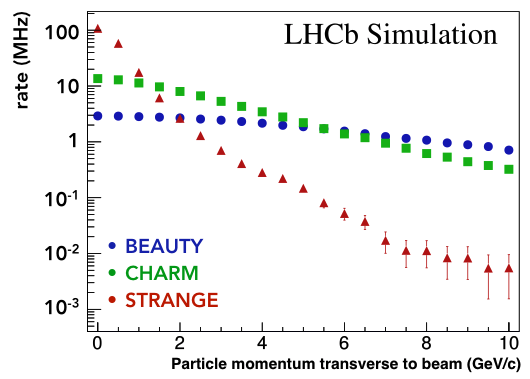

Last week, the LHCb collaboration met in Annecy to plan a second upgrade of the experiment. The first LHCb upgrade, which is being built right now and will take data from 2021, will collect 10 times today's data rate. But the second upgrade, if built, will allow LHCb to collect data 100 times faster than today. If approved, from 2030 LHCb would process around 500 Terabits each second, around ten times more data than any previous High Energy Physics experiment and bigger than even the Square Kilometre Array!
As the image shows, at this data rate the LHCb experiment will "see" tens of millions of interesting particles per second, for example those containing "beauty", "charm", or "strange" quarks. By precisely measuring their properties LHCb will test our best current theories of microscopic nature, and perhaps find new particles or forces which lie beyond them. But there is a catch -- because LHCb will see so much signal, the experiment will have to automatically analyse the signal properties in real time, before saving an enormously reduced snapshot of its most interesting findings for further inspection by physicists.

RECEPT researchers contribute to data processing in both LHCb upgrades, and last week presented their ongoing work in these areas. At the 2018 Connecting the Dots workshop, Renato Quagliani spoke about the reoptimization of charged particle reconstruction for the LHCb upgrade, and a recent speedup of a factor 3 in the first stage of this reconstruction. Meanwhile at the Annecy meeting for the second upgrade, Vava Gligorov spoke about the challenges of analyzing the same data rate as today's entire internet traffic.
Crucial to both efforts will be to redesign the algorithms which reconstruct particle trajectories in the experiment, and allow physicists to measure those particle's properties. Although the current algorithms have been optimized over many years, they are fundamentally sequential in nature, and build up an image of what happened in the experiment by finding one trajectory after another. This makes them inefficient at using today's highly parallel computing architectures, whether multi-core CPU processors or the graphics cards which increasingly power commercial processing centres. In addition to teaching our algorithms to find many trajectories at once, we must also redesign our data structures so that detector signals which come from the same particle trajectory are placed close to each other in the computer's memory, speeding up our calculations. Although we have made first steps towards this redesign, this work is only beginning and will occupy both RECEPT researchers and many of our LHCb colleagues for years to come!
-- V.V.G., 26 March 2018
The RECEPT project welcomes Dorothea vom Bruch, who joins us having done her PhD thesis at Heidelberg! Dorothea already studied both lepton universality and lepton flavour violation during her masters and PhD theses, and will now study lepton universality as well as the reconstruction of the upgraded LHCb detector, with a particular focus on optimizing our reconstruction software for highly parallel architectures. Read more about her on our members page! -- 01.12.2017
The RECEPT project welcomes its first researchers! Florian Reiss and Da Yu Tou join us as doctoral students having completed their Master's theses at the Universities of Heidelberg and Manchester, respectively, in order to study lepton universality in the decays of b-mesons. Renato Quagliani joins as a postdoctoral researcher having obtained a joint doctorate from the universities of Bristol and Orsay (Paris 11), and will study lepton universality as well as the reconstruction of the upgraded LHCb detector. Read more about them on our members page! -- 01.10.2017